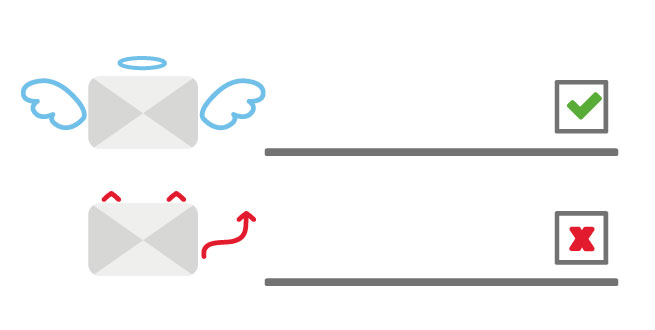Blacklists and Whitelists: what are they and how they affect deliverability
Published in january, 28 of 2016
In a world ruled by automated email marketing campaigns, reaching your target audience can be a hard task to be accomplished. To overcome this mission, you have the support of two concepts that can directly impact on deliverability rate: whitelists and blacklists. If you donít know one or both terms, youíre passing up a good opportunity to improve the results with your messages.
Before enjoying all the advantages of whitelists and blacklists, you must understand the meaning of each term so you can apply them in practice. So letís go to the concepts:
How to win the confidence stamp from a whitelist for your email
Being directed by your own target audience as a trusted sender is a big bonus for your company, in addition it transmits security, credibility and good reputation. Besides all that, it increases the delivery chances for your campaigns.
In this context comes the Whitelist, also called 'list of good', consisting of a set of emails, domains or IP addresses previously approved and with delivery permission, without the need to undergo antispam filters. By integrating this list, your company is seen as a trusted sender and free of spamming.
Any email off this list is filtered as ďjunk mailĒ or placed in the folder from unknown senders.
These selected emails, domains or IPs indicates another function: blocks a high rate of spam, which is good for the user. And itís also good for you, since you will be well seen with a reputation beyond reproach. So the whitelist is used by most email providers as a filter between what will be delivered and what will be blocked.
To receive this certification, you must apply the best practices of email marketing, starting with the permission policy (opt-in). It's like being in the VIP list for a trendy party. The stay, however, may be canceled if your company send unwanted emails or receive any complaints.
How to avoid the dreaded fate of a campaign falling in blacklist
With the volume of daily emails submissions and also some spamming increasing, the term blacklist conquered even more strength in the vocabulary of those who deal with email marketing.
Blacklist is composed of emails, domains and IP addresses classified as poor because of the spamming senders. Available to the public, itís used for the IP block on the servers and their impact can cause financial loss for businesses and create a negative customer experience. Being part of this relationship, you lose the right to deliver your messages into the Inbox of one or more users, because they come to be directed straight to the spam box.
The first step to not fall on this list is to understand how the blacklists act and when companies are at risk. This means the practice of spam by sending unwanted emails, without permission (opt-in). When an email, domain or IP is on this blacklist, the provider may refuse the receipt of the message by not considering the address reliable.
Do you know what are the most common blacklists? Return Path has prepared an infographic with key addresses, including time and peak days, among other things. Click here.
To escape this undesirable list, you should avoid emails in large quantities; with malicious, prejudiced or pornographic content; and even with viruses or malicious software.
Do you have any questions? Visit the site www.senderscore.org and find out if your company faces some difficulty. This address offers free consultations on the reputation of email sending domain.
So what can you do to do to keep your emails safe?
You should receive several email marketing campaigns daily and many of them directly in your spam box, then you donít want your company to follow the same path. The best way is working with a contact list grounded in the opt-in policy, built by yourself and with permission to send emails.
You should also follow the best practices of email marketing, identifying who you are on the sender space, segmenting your lists and adapting your content to these segments, sanitizing your database from time to time and not bombarding the inboxes of your recipients with thousands of emails.
Remember also to provide the option to opt-out. If you donít want to break the law, you should not prevent anyone who wishes to no longer receive your emails. By the standards set out in the Can-Spam Act, you must facilitate the cancellation by providing a clearly visible link at the bottom of all outgoing messages. Also, you must honor any request as soon as possible.
To improve this situation and keep the cancellation fees low, you should segment your contact lists and target content according to the interests of each group. You can also offer options and ask your contact what type of content it would welcome from your company.
So if you follow best practices, avoid purchased mailing lists (without opt-in) and comply with the policies of email providers, you can use email marketing to leverage your business.
Did you like the content? Share it!